ASIA’S FUTURE CITIES: Phnom Penh's development offers uncertain future for the urban poor
As Phnom Penh grows and develops, poorer residents are running out of room as big development projects replace the places they call home.
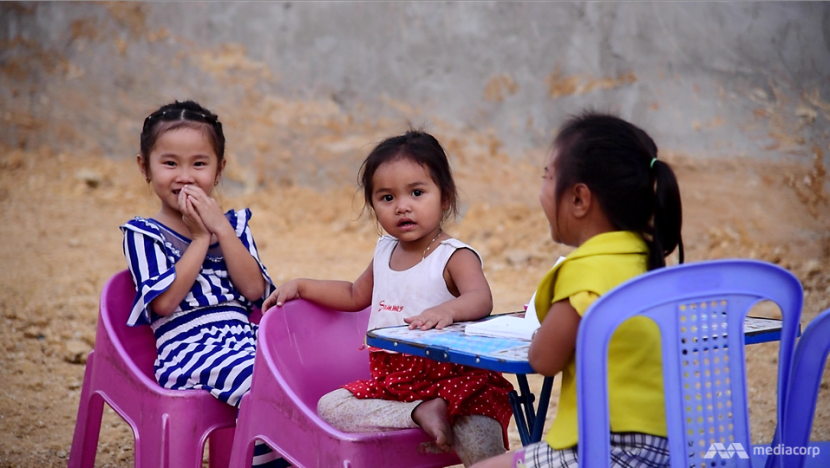
Children playing on empty land in Thmor Kol village. In 2012, more than 180 families were forced to move out to pave the way for a planned airport expansion. (Photo: Pichayada Promchertchoo)
PHNOM PENH: On November 19, 2012, when Air Force One descended on Phnom Penh’s international airport, former US President Barack Obama was meant to see a message – from the sky.
The residents of Thmor Kol village near the runway hoped the US leader would recognise his face on big posters and, next to it, a signal of distress - SOS - brightly painted on the rooftops of their ramshackle homes.
Their motive was despair. More than 180 families had been forced to move because their homes stood in the way of a planned airport expansion. According to city officials, they were illegally constructed and no compensation would be given.
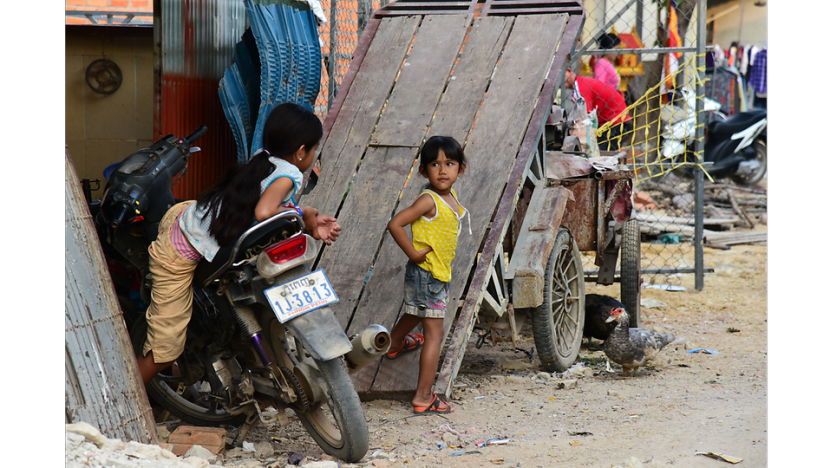
Many residents of Thmor Kol village were forced to move out without compensation. (Photo: Pichayada Promchertchoo)
In the end, Mr Obama never saw their message. Armed security officials showed up at Thmor Kol before his arrival. They erased the SOS signs, took down the posters and detained eight villagers. One of them was a fruit seller named Chry Nim, whose idea for the artwork drew international attention to the plight of Phnom Penh’s urban poor and their constant struggle against forced eviction.
"When the authorities want some expensive plot of land, they’ll use power and intimidation to kick people out,” Nim told Channel NewsAsia. “They’ll accuse people of living illegally. But many don't. They just didn't know their rights.”
But as Phnom Penh continues its development - with burgeoning satellite towns and modern infrastructure – the likes of Nim could soon run out of places to call home.
In recent decades, a real estate boom has transformed the city from a war-torn capital into a vibrant urban metropolis, with hundreds of skyscrapers and big development projects. Luxury condominiums and modern office buildings have formed its new skyline. But for those struggling to make ends meet, much of the development came at a cost.
“Developers are using their sand to flood our homes,” Nim said.
FOR THE RICH, NOT THE POOR
Every day, the sound of drill hammers and heavy construction trucks washes over Phnom Penh as it transforms to meet the needs of a rapidly growing population.
The United Nation’s World Urbanization Prospects estimates there will be 2.3 million inhabitants in the city by 2025, up from 1.7 million in 2015. But according to Phnom Penh governor Pa Socheatvong, the population might have already hit three million last year due to a steady influx of migrants from the provinces. And that means more cheap housing is needed - and soon.
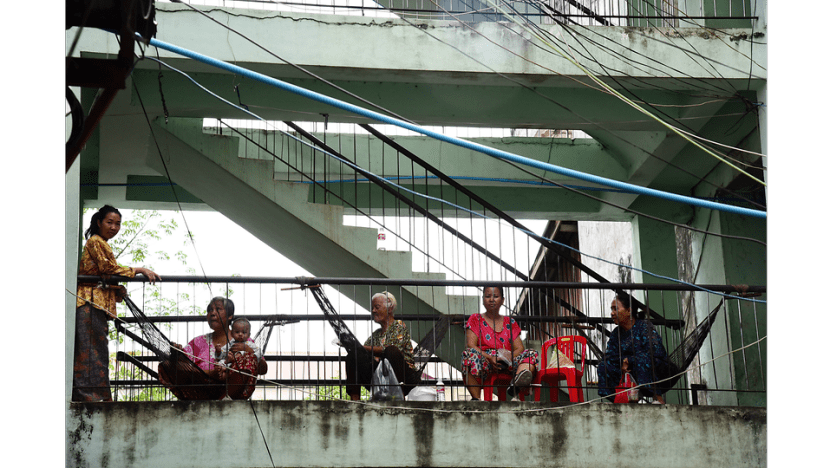
An estimated 140,000 people are living in more than 500 slums across Phnom Penh. (Photo: Pichayada Promchertchoo)
“Phnom Penh already has 215 urban poor communities but hardly any affordable homes. So these people have to live near open sewage canals and lakes, like Boeung Tompun, which is now being developed for a high-end project,” said Sia Phearum from the Housing Rights Task Force (HRTF), a leading NGO that fights to end forced eviction in the capital.
“More and more people are coming from rural areas. But the government is only focusing on the rich and upper-middle class.”
But while NGOs claim there is an imbalanced supply of housing in Phnom Penh, Beng Hong Socheat Khemro, director general of the Housing Department, told Channel NewsAsia that the government is working to address the shortage of affordable homes.
“I agree there are many housing projects that only cater to the high-end bracket of the market. But within 5-10 years, I’m hopeful the middle and low income groups will be able to have decent houses,” he said.

An apartment inside an affordable housing complex in central Phnom Penh. (Photo: Pichayada Promchertchoo)
In the national housing policy, the government states that Cambodia will need 1.1 million new houses by 2030 to accommodate more than 18 million residents across the country. And for that to happen, it plans to entice private developers into supplying cheap homes in exchange for tax incentives.
“An incentive programme is still being discussed,” Khmero said.
Although details are yet to be finalised, the director general shared a rough plan for the scheme: “People can pay (developers) US$80-150 per month for a long-term mortgage and own a property, say, after 20 years. Currently, they can't apply for a mortgage with the bank without an asset but with this plan, they’ll have an opportunity to own an affordable home without necessarily owing the bank money.”

"Developers are using their sand to flood our homes." (Photo: Pichayada Promchertchoo)
However, the targeted beneficiaries will be middle income earners rather than the poor. “Nothing can be taken for granted. You have to have a sustainable income in order to afford an affordable home,” Khemro added.
But as land prices continue to soar, doubts have been raised about whether businesses will be interested in developing more affordable homes when big money can be made at the higher end of the property market.
THE WHITE BUILDING
Today, an estimated 140,000 people are living in more than 500 slums across Phnom Penh. Based on what Khemro said, their future may depend on the attitudes of private developers.
One has already put forward a plan which could meet the needs of one of those communities while still being commercially attractive.
In partnership with the Ministry of Land Management, Urban Planning and Construction, Japanese company Arakawa has proposed developing one of Phnom Penh’s landmarks, the White Building, a complex of low-cost apartments built in 1963.
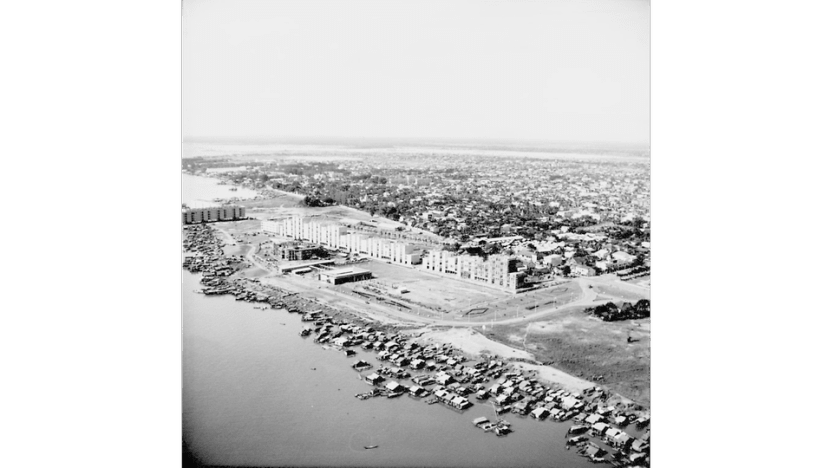
An old photograph shows the White Building after its completion in 1963. (Photo: White Building Archival Images)
Once the pride of Phnom Penh’s golden architectural era, the four-storey structure was a modern housing project for urban Cambodians. Today, the apartments are dilapidated and crammed with thousands of low-income earners and small business owners. Once bone-white facades are now grey and crumbling, covering dark corridors, decrepit staircases and decaying homes.
But the White Building is slated for a facelift. According to the development plan, it will be torn down and replaced with a 21-storey condominium tower. The project is expected to take four years to complete and cost US$70-80 million. Once finished, five floors would be given to the existing families. Four would become a parking lot and retail space, while the top 12 storeys would be for Arakawa to manage.
So far, no agreement has been reached between the developers and the residents, who would have to wait at least four years in a temporary resettlement site about 8 kilometres away. But many of them do not want to wait that long.
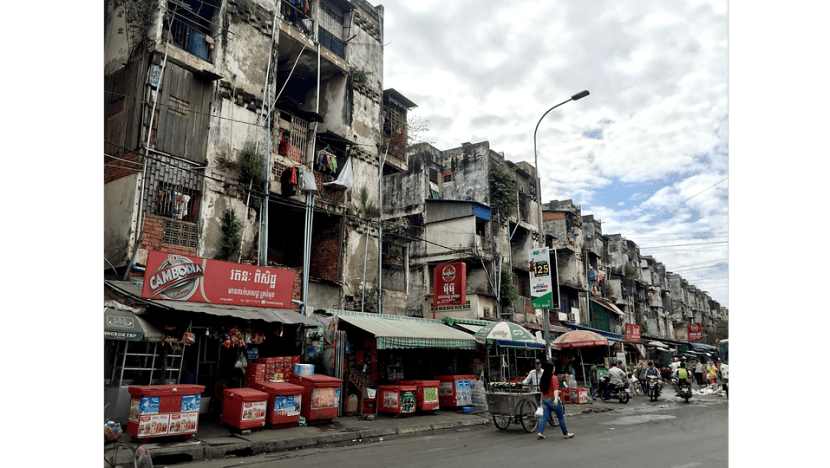
Once the pride of Phnom Penh's golden architectural era, the White Building today is old and crumbling. (Photo: White Building Archival Images)
“About 85 per cent of the residents want to get cash and leave,” said Sea Vouch Eng. She has been a resident of the White Building since 1990. And like most of her neighbours, she does not want to wait.
“I don’t trust them. The Japanese are respectful but I’m more worried about their Cambodian partner. I’m afraid once we’ve left, they won't let us return.”
Eng cited a major land dispute in Borei Keila in central Phnom Penh, where the developer promised to build ten apartment buildings for more than 1,776 families in compensation for their eviction. However, only eight were built, resulting in 384 families being left homeless.
“I fear history would repeat itself,” she added.
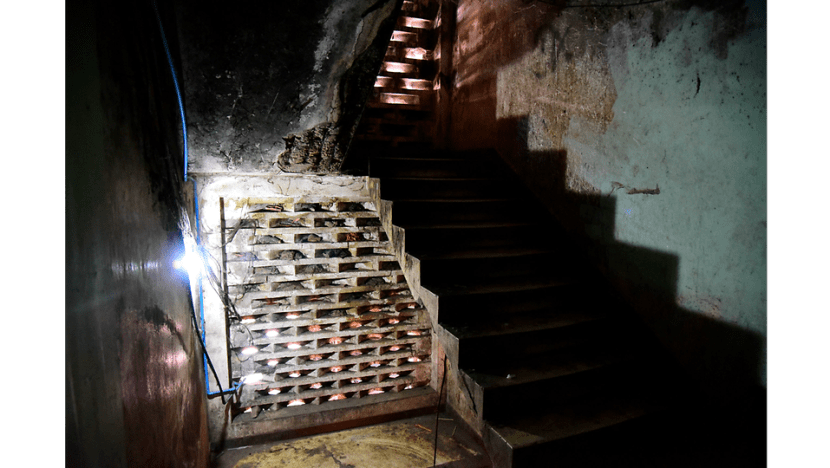
A decrepit staircase inside the White Building. (Photo: Pichayada Promchertchoo)
Violation of land rights is an issue in Cambodia. According to Phearum, 770,000 people - about 5 per cent of the 15 million national population - are victims of land disputes. And many cases involve people with political connections.
So when the government wants to promote affordable housing, gaining trust from local residents can be a challenge.
“The system is very corrupt, from top to bottom. And that’s a major obstacle for affordable housing in Phnom Penh,” Phearum said.
“For the White Building, even though it’s an affordable housing project, people just don't trust the government. Otherwise, it'd be a good model for other millionaires in the future.”
“NO HOUSE MEANS NO LIFE”
As policy makers discuss housing plans and investors assess profit margins, low-income residents of the city watch developments carefully.
For those threatened with eviction, some are gearing up to assert their rights.
“The SOS airport community has formed an alliance with three other similar groups...If we just fight on our own, our voice will be very weak,” Nim said.
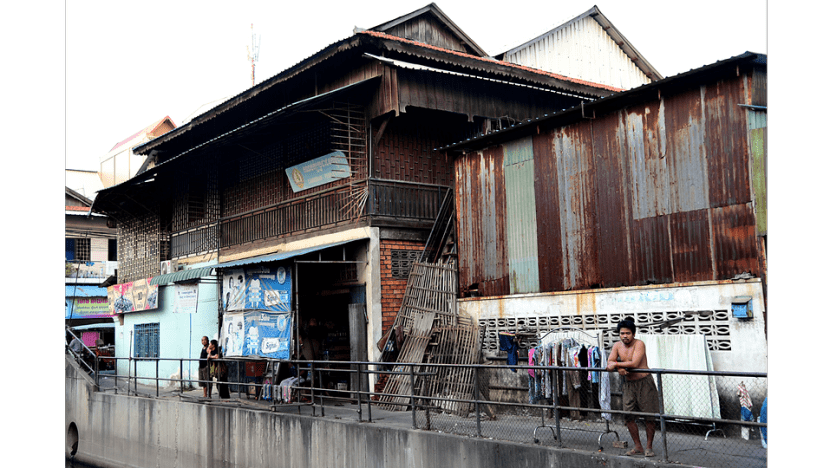
A man stands by an open sewage canal, where low-income earners live. (Photo: Pichayada Promchertchoo)
Their voice is growing louder. Every week, the alliance holds a meeting, where they discuss land rights, human rights and laws, and form a strategy to demand solutions from the government.
“Only when people stand united can they demand affordable homes. When a baby wants milk, it cries. So the poor have to cry because if they don't, the government won't care. Now, many babies are crying. And the government has to find a way to address their problems,” Phearum said.
Thanks to the movement, Thmor Kol village has survived. The planned expansion was cancelled and every family was allowed to continue living near the airport. The residents are now waiting for land titles, which they hope to get before the general election in 2018 and which would give them certainty about their future.
“No house means no life. Even birds have nests," Nim said. "So we have to fight for our house."
Follow Pichayada Promchertchoo on Twitter @PichayadaCNA












